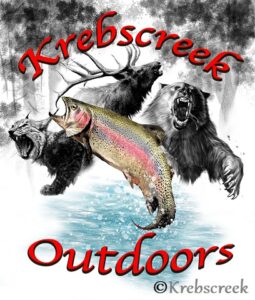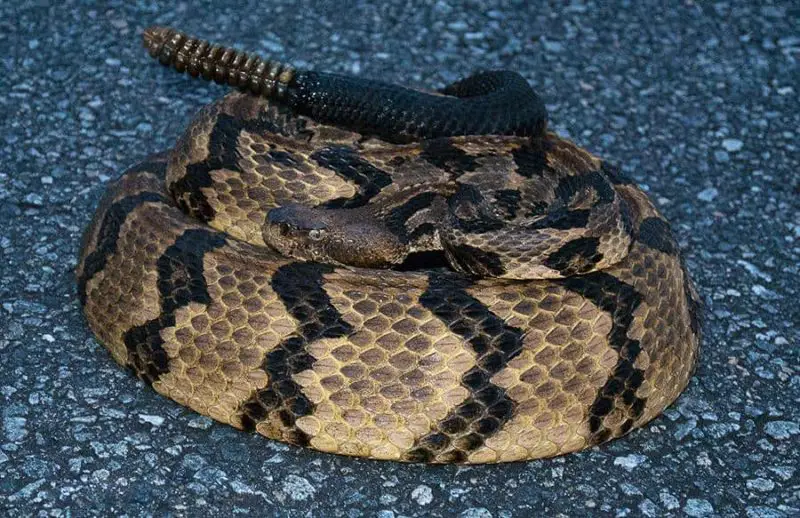There are two species of venomous snakes in Minnesota. They’re the Timber Rattlesnake and the Eastern Massasauga Rattlesnake.
Despite the potential danger these snakes present, they’re also a vital part of the ecosystems that they inhabit. Their main contribution is keeping rodent populations and the pests accompanying rodents, such as fleas and ticks, in check.
Both of these snakes are potentially dangerous to humans. In fact, according to the World Population Review, Minnesota’s venomous snakes bite around 3 people in an average year.
Anyone who spends time in Minnesota’s outdoors will be safer if they learn where the populations of Timber Rattlesnakes and Eastern Massasauga Rattlesnakes are within the state. It’s also important to know how to recognize these snakes and how to safely coexist with them.
This comprehensive guide will give you the information you need to stay safe in the outdoors with Minnesota’s venomous snakes.
Pit Vipers: The Venomous Masters of Infrared Detection
Rattlesnakes, Copperheads, and Cottonmouths are the snakes in the United States that belong to the Crotaline subfamily of the venomous Viperidae family, also referred to as pit vipers. Since the Eastern Massasauga Rattlesnake is a pit viper, let’s learn more about them.
What Makes Pit Vipers Unique?
- Infrared-Sensing Pits:
A defining feature of pit vipers is the deep facial pit between their nostril and the eye on each side of their head. These specialized infrared-detecting organs allow pit vipers to sense heat emitted by prey. This adaptation enables them to:- Detect body heat from up to 1 meter away.
- Strike prey with pinpoint accuracy, even in complete darkness.
- Triangular Heads and Vertical Pupils:
- Head Shape: Pit vipers are recognized by their distinct triangular-shaped heads, which house their venom glands.
- Eyes: They have vertical elliptical-shaped pupils.
- Venomous Fangs:
Pit vipers have hollow fangs connected to venom glands. These fangs fold back against the roof of their mouth when not in use. All pit vipers are born with multiple fangs and replace them every couple of months. Old fangs are shed one at a time. Consequently, a pit viper bite may only involve one fang. - Pit Viper Bites: Interestingly, these snakes have a sphincter on each venom gland. This allows them to control the flow of venom through the fangs. A snake may elect not to inject any venom with a bite. Scientists surmise this is because rebuilding its venom store takes time. Twenty to twenty-five percent of pit viper-to-human bites are dry bites.
Ecological Importance
Pit vipers play a crucial role in maintaining ecosystem balance by controlling rodent populations. Despite their fearsome reputation, these snakes are vital to the health of many habitats.
Rattlesnakes
What Minnesota’s Rattlesnakes have in common with most rattlesnakes is the rattle at the ends of their tails.
- Most rattlesnakes have a rattle at their tail’s end, comprised of hollow, loosely interlocked keratinous scales.
- Normally, a rattlesnake adds a new segment to its rattle each time it sheds its skin.
- An agitated rattlesnake rapidly vibrates its tail, causing the segments of its rattle to vibrate together, creating a buzzing or rattling sound.
- An Eastern Massasauga’s rattle is more of a buzzing sound, very similar to the buzzing of a bee.
- Not all rattlesnakes rattle before they strike. Sometimes, they lose their rattles due to injury, and sometimes, they choose not to rattle.
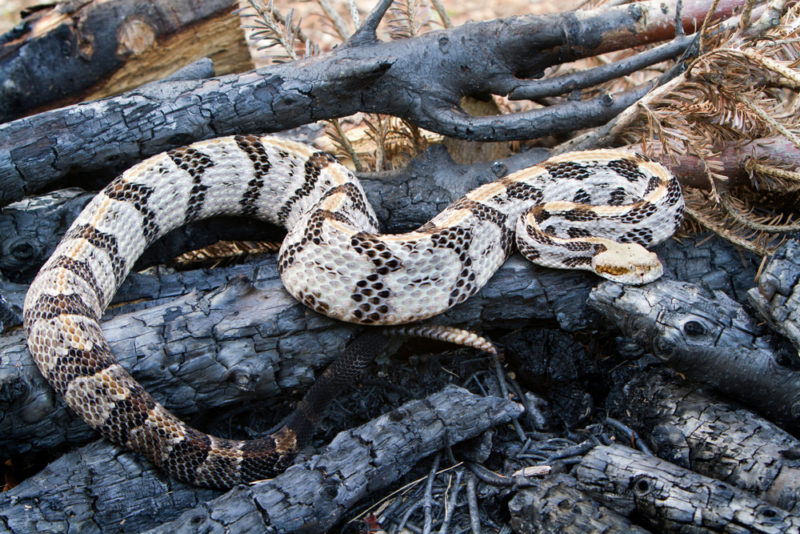
Timber Rattlesnake (Crotalus horridus)
Timber Rattler and Canebrake Rattlesnake are both common names for the Timber Rattlesnake. Generally, in higher-elevation habitats, they are called Timber Rattlesnakes. On the coastal plain, though, they’re called Canebrake Rattlesnakes.
What Do Timber Rattlesnakes Look Like?
| Size | *Average length: 36 to 60 inches (0.91 to 1.52 m). *Rare cases reported: Up to 7 feet (2.13 m). |
| Coloration | *General base color: Yellowish-brown to grey-brown. *Chevron pattern: Dark brown to black chevrons on their back and sides against a lighter base color. *Back stripe: Rusty to reddish stripe running down their back. *Tail color: Dark brown or black. |
| Melanistic Variation | *Some timber rattlesnakes exhibit a dark, melanistic color morph. *These snakes can appear almost entirely black. *The tail is darker than the rest of the body in this morph. |
| Behaviors | *These snakes are excellent climbers. In fact, timber rattlers have been found in trees at heights of more than 80 feet. *The experts have proven that timber rattlesnakes help control Lyme disease. This is because as they consume rodents, they’re also consuming ticks. A timber rattler will consume 2,500 to 4,500 ticks per year, depending on the location. |
| Conservation Status | The Minnesota DNR has listed the Timber Rattlesnake as a threatened species. |
Timber Rattlesnakes in Minnesota: Where Do They Live?
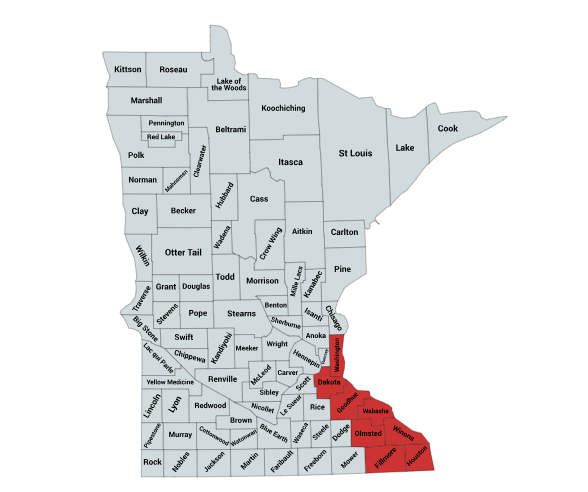
Timber Rattlesnakes in Minnesota inhabit the southeastern portion of the state. They’re in Washington, Dakota, Goodhue, Wabasha, Olmsted, Winona, Fillmore, and Houston counties.
The Timber rattlesnake lives in various habitats. These include deciduous forests, pine forests, and agricultural fields. They can also be found in wetland habitats and river flood plains.
As we talked about, Timber Rattlesnakes are ambush hunters. When not on the move, they’re likely lying motionless in a potential ambush spot. They often employ ground debris as an additional layer of camouflage.
What Do Timber Rattlesnakes Eat?
Timber rattlers prey on small rodents such as mice, rats, squirrels, and chipmunks. They also eat small birds, other reptiles, and amphibians.
How Dangerous Are Timber Rattlesnakes?
- Timber Rattlesnakes are among the most dangerous in the United States. This is due to their long fangs and high venom yield. 1% to 10% of untreated Timber Rattlesnake bites result in a fatality.
- Fortunately, 40% to 60% of the time, they produce dry bites. In other words, although their fangs penetrate the body, they do not inject any venom.
- These snakes produce hemotoxic venom. Timber Rattlesnake bites sometimes cause serious complications. These include shock, seizures, coma, internal bleeding, and deep tissue damage.
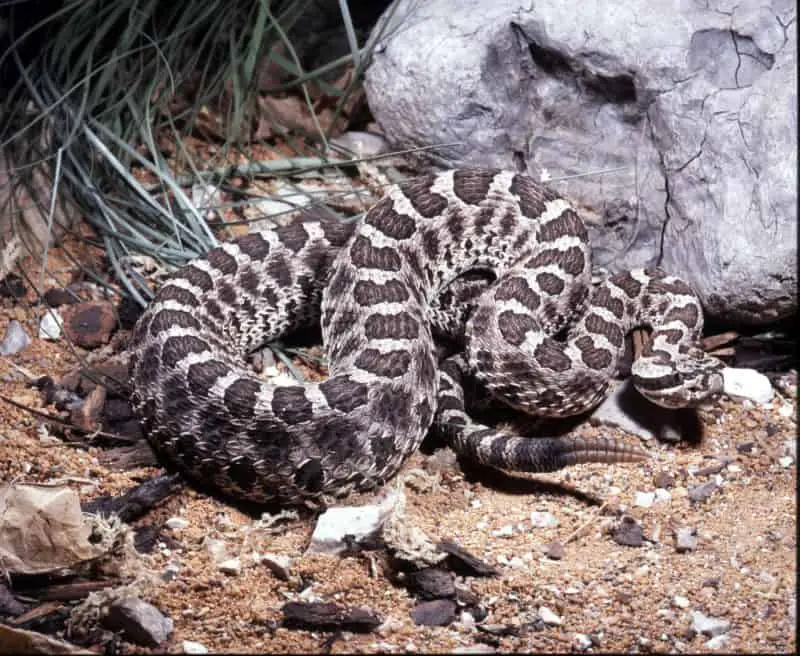
Eastern Massasauga Rattlesnake (Sistrurus catenatus)
Massasaugas have a high-pitched rattle sound, which is different from other rattlesnakes. This is why they have the nickname Buzztail.
| Size | *Adult Eastern Massasaugas average 22 to 30 inches (55 to 75cm) long. |
| Coloration | *A row of large, rounded, blackish-brown spots run down their spine. *They have three smaller rows of spots down each side. *Sometimes, the larger dorsal spots connect with the side spots, forming a large solid blotch. |
| Dorsal Spots | *A row of large, rounded, blackish-brown spots run down their spine. *They have three smaller rows of spots down each side. *Sometimes, the larger dorsal spots connect with the side spots, forming a sizeable solid blotch. |
| Head | *A dark stripe on each side of their face and across their eye. |
| Conservation Status | *The Minnesota DNR has listed the Timber Rattlesnake as an endangered species. |
Eastern Massasaugas are sometimes called swamp rattlers. They are one of two rattlesnake species native to the Great Lakes states. The other is the Timber Rattlesnake.
Minnesota Snakes That Resemble the Eastern Massasauga
Western Fox Snakes and Eastern Milk Snakes are non-venomous snakes in Minnesota. Both have color patterns similar to those of Eastern Massasauga. Sometimes, when these snakes are agitated, they mimic the tail shake of a rattlesnake. The effect can be pretty convincing if their tail vibrates against dry leaves. However, neither of these harmless species has rattles. They also lack the triangle-shaped head of a pit viper.
Where Do Eastern Massasauga Rattlesnakes Live in Minnesota?
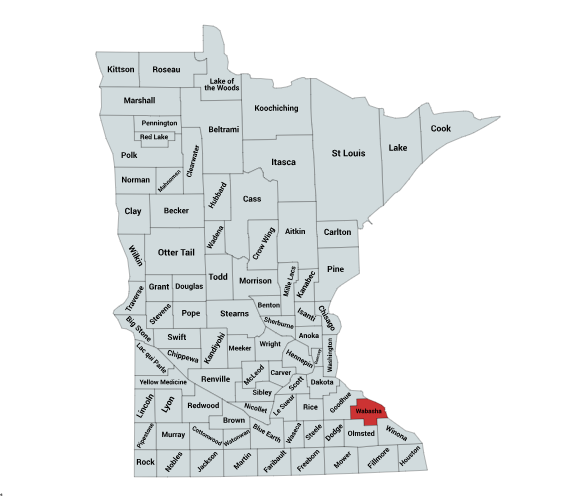
There are very few Eastern Massasaugas living in the North Star state. According to the Minnesota Department of Natural Resources, the Eastern Massasauga is endangered. This is due to habitat loss.
The extant Eastern Massasaugas are in southeast Minnesota in Wabasha County. They inhabit wet habitats. These include forested swamplands, marshy grassy areas, and lake edges. To a lesser extent, they also inhabit dry prairie and woodlands.
What Do Eastern Massasauga Rattlesnakes Eat?
Eastern Massasaugas prey on smaller rodents such as mice and voles. They also eat frogs, toads, and small snakes.
How Dangerous Are Eastern Massasauga Rattlesnakes?
The venom of the Eastern Massasauga rattlesnake is cytotoxic. Cytotoxic venom destroys body tissue. Moreover, digestive enzymes in cytotoxic venom disrupt blood flow and prevent clotting. Massasauga bites to humans are rare. However, they do occur.
There are two documented deaths in Ontario from Eastern Massasauga bites. In each case, the victim did not receive antivenom in time.
Wild Cats in Minnesota – Krebs Creek
Minnesota’s Venomous Snakes in Winter: Insights into Brumation
During winter, Minnesota’s snakes, like all reptiles, enter a dormant state called brumation—a hibernation-like period. Because snakes are ectothermic (cold-blooded) and cannot regulate their body temperature internally, they slow their metabolism and become inactive during the colder months.
Brumation Habits
- Solo vs. Communal Brumation: Some snakes brumate alone, while others gather in communal dens. For example, Eastern Copperheads and Timber Rattlesnakes often share dens, which may house up to 60 snakes.
- Mixed-Species Dens: Interestingly, these dens can include non-venomous species. It’s not uncommon to find Black Rat Snakes sheltering alongside venomous snakes.
- Unlike Timber Rattlesnakes, Minnesota’s Eastern Massasauga Rattlesnakes usually spend the winter in solo dens or groups of 2 to 3
Regional Variations
- Snakes may only seek shelter in warmer areas on the coldest winter days. They might not enter full brumation due to milder conditions.
Where Snakes Spend Winter
Snakes seek out protected spots to brumate, such as:
- Rock crevices
- Hollow logs
- Fissures on rocky hillsides
- Snake dens are often on south-facing slopes because these areas receive more sunlight, providing additional warmth during winter.
- Eastern Massasauga Rattlesnakes prefer wetland environments. They often spend the winter months in abandoned crayfish burrows.
This natural adaptation allows Minnesota’s venomous snakes to survive the winter and re-emerge when temperatures rise.
Avoiding Snake Bite
Snakes, including venomous ones, commonly rely on their camouflage to avoid potential threats. They often remain perfectly still to avoid detection. If you’re walking in the woods and unknowingly get too close, a snake might not move, hoping you’ll pass by. This is particularly true of copperheads. Many bites happen when someone accidentally steps on or close to the snake. To stay safe in snake habitats, always watch where you step and where you place your hands.
Another common cause of snake bite is attempts to capture or kill a snake. Remember, venomous snakes can strike instantly, delivering a potentially life-threatening bite. The safest approach is to keep a safe distance and leave them alone.
Dressing for Snake Country
- High-top leather boots and long pants are both wise ideas.
- Also, wear loose-fitting denim. If there’s a gap before the snake’s fangs touch your skin, your chances of being envenomated are lower.
- In the absence of high-top leather boots, some people wear snake gaiters.
Symptoms of Venomous Snake Bites
Some of the symptoms you may experience when a venomous snake bites you include:
- Discoloration in the area of the bite.
- Swelling in the area of the bite.
- Loss of muscle coordination.
- Tingling sensation in the area of the bite.
- Feeling nauseous.
- Having a faster heartbeat or rapid pulse.
What Should You Do if You Are Bitten?
If you or someone you are with has suffered a venomous snakebite, time is of the essence. Because the sooner a victim receives antivenom, the less chance the venom in their body has to cause harm. In other words, it is important to seek immediate medical attention.
Do not attempt to kill the snake for identification purposes. This gives the snake a chance to bite you again. Also, consider that severed snakeheads can still bite and envenomate and often do. If you have a phone, take a picture of the offending reptile. Otherwise, get started on your way to the nearest hospital.
First Aid for Snake Bite Victims
- The best thing you can do is remain calm and limit your movements. Do not run. If you must hike back to a vehicle, do it calmly and deliberately. Put as little stress on your heart as possible.
- Keep the area of the snake bite below the heart level and never above the heart level. Keeping the bite below the heart level will reduce the venom’s flow. However, holding the bite above your heart level will increase the venom’s flow.
- Remove all constricting items such as bracelets, watches, or rings before swelling occurs.
- Remember that using a cold compress on a venomous snake bite is not advisable. The cold may cause the local blood vessels to constrict and spread the venom faster.
- You can wash the affected area like any other wound with soap and water.
- You may cover the bite area with a moist dressing to reduce the swelling.
- Get prompt medical treatment. Call the hospital to tell them a venomous snake has bitten you. So they can have antivenom ready to give you when you arrive.
- A person whom a venomous snake has bitten may go into shock. If this happens, lay them flat and cover them with a blanket.
Conclusion
Minnesota’s Timber Rattlesnake and Eastern Massasauga Rattlesnake are fascinating yet misunderstood creatures. These venomous snakes play an essential role in the state’s ecosystems by controlling rodent populations and even indirectly reducing the spread of tick-borne illnesses. However, their presence also highlights the importance of understanding how to coexist with wildlife safely.
By learning to identify these snakes, recognizing their habitats, and following safety precautions, outdoor enthusiasts can reduce the risk of encounters while appreciating the natural beauty of Minnesota’s landscapes. Always respect their space, dress appropriately for snake country, and stay vigilant to ensure a safe and enjoyable outdoor experience.
For those bitten by a venomous snake, prompt medical attention is critical. Familiarizing yourself with first-aid measures and staying calm can make a life-saving difference.
Ultimately, the Timber Rattlesnake and Eastern Massasauga are symbols of Minnesota’s biodiversity and reminders of nature’s delicate balance. With knowledge and respect, we can share the outdoors with these remarkable reptiles responsibly and safely.
Recent Posts
The only venomous snakes in Washington State are Northern Pacific Rattlesnakes. The Northern Pacific Rattlesnake (Crotalus oreganus oreganus) is a sub-species of the Western Rattlesnake. Anyone...
Skunks are not classified as true hibernators. But they go into a state of torpor when the weather gets cold. Skunks are light sleep hibernators, along with opossums, bears, and raccoons. ...
